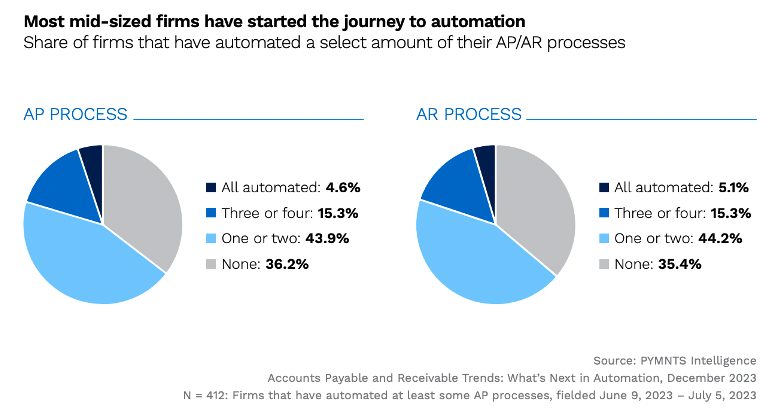Only 5% of Mid-Sized Firms Have Fully Automated Accounts Payable, Receivable

Accounts payable (AP) and accounts receivable (AR) are two of the areas that typically entail more processing time and involvement of the workforce.
Traditionally, managing B2B payment processes means a lot of manual tasks in invoicing, accounting or payment processing. Thus, implementing effective automation in any of these areas means reducing processing times, streamlining operations and freeing up part of the workforce, which is ultimately translated into cost savings.
Firms are aware that the automation in AP and AR has a direct impact on their cash flow management. However, few have fully completed the automation of their AP and AR processes.
By the Numbers
These are some of the key findings in the PYMNTS Intelligence study “Accounts Payable and Receivable Trends: What’s Next in Automation.” The study was based on a survey of 412 executives from mid-sized firms with day-to-day and strategic leadership responsibilities in AP, AR and payments strategy. The study defined mid-sized companies as those generating between $3.5 million and $15 million of annual revenue.
The Journey to Automation
Only 5% of mid-sized firms have fully completed the automation of all processes, and 15% have automated three or more tasks, the study found. Nearly 44% have only automated one or two AP or AR tasks, and more than one-third have not started any automation and are still anchored in paper and manual duties.

What’s Next
According to the study, most mid-sized firms plan to automate their AP and AR operations, implying that a reduction in manual AP and AR processes is on the horizon. Among the top tasks firms will automate are payments of regular amounts or occurring at regular intervals, payments involving greater calculations, and payments that offer discounts for being paid faster.
One trend that reshaped B2B payments in 2023 is that business customers expect the same, seamless and technology-driven experience in B2B transactions as they receive in their day-to-day lives as consumers.
“In general, business customers are no longer accepting of the clunky manual processes long associated with B2B accounts receivables,” Shawn Cunningham, managing vice president and head of Capital One Trade Credit, told PYMNTS in an interview posted in October.
Executives from companies of all sizes are starting to flag the inefficiencies derived from existing B2B payment workflows. Manual invoicing and reconciliation, general lack of clarity, proliferation of errors, and excessive processing times are some of them.
The benefits and cost savings associated with AP and AR automation are clear, according to Nathan Bhatt, vice president of B2B products and partnerships at American Express.
“Research shows that automating accounts payable processes can save finance teams on average 9.9 hours per week,” Bhatt told PYMNTS in an interview posted in October. “That’s over 500 hours per year, which represents a huge saving for business leaders — especially those looking to juggle a huge set of priorities while trying to focus on what matters: growing their business.”
For all PYMNTS B2B coverage, subscribe to the daily B2B Newsletter.

